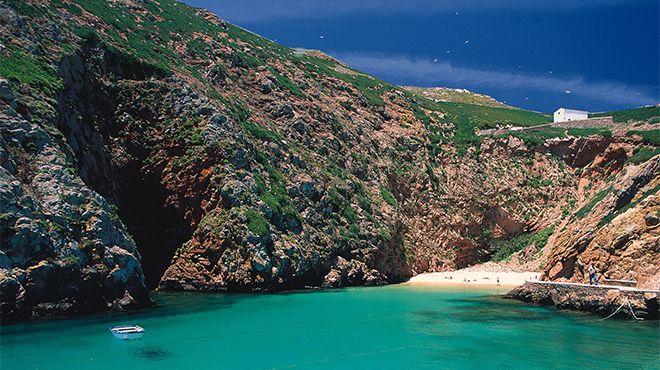Peniche

Peniche
Towns and Villages
In Peniche, the fortress that D. João IV ordered to be built in the seventeenth century was, like the forts on Consolação beach and the S. João Baptista fort on the Berlenga Islands, an important military complex for protection against invasions from the sea. The fort in Peniche, which was turned into a political prison in the period of the Estado Novo or "New State" (1933-1974), was the scene of one of the most extraordinary escapes of the twentieth century in Portugal. In 1960 a group of political prisoners escaped from it, among them Álvaro Cunhal, the communist leader. Visit the interesting museum space, which recreates the prison environment and contains various thematic areas relating to the region.
Fishing is still an important activity in Peniche, and people love to watch the the boatloads of fish coming into port. The regional gastronomy takes full advantage of the abundance of fish in the sea. We therefore heartily recommend that you seek out restaurants in the Avenida do Mar that will serve you a caldeirada (fish casserole), sopa de lagosta à moda de Peniche (Peniche-style lobster soup), arroz de marisco (shellfish risotto) and many other dishes that all use the best fresh fish available.
Peniche is the largest centre in Portugal for bobbin lace, a centuries-old art whose origins are lost in time. It may have been a way for the women to occupy their time while their husbands were away at sea. A delicate art acquired through skill and patience, it is represented at international events, and is an artistic legacy that is well worth preserving.
Before entering the town of Peniche, go to the coast and gaze in wonder at the marvellous view of the sea. Whether it is bright blue or deep green, calm or breaking against the rock cliffs in fierce waves, this sea has formed sculptures on the rocks that have taken on strange and dramatic shapes resembling enormous tumbledown monuments.
Visit the beach of Baleal (meaning whale), which stretches between two seas as if it was an island (which in fact it was). Like Consolação beach further south, its excellent conditions for surfing and bodyboarding make it very popular. The Papôa promontory, protruding on the left, brings to mind tragic shipwrecks, such as that of the "São Pedro de Alcântara", a Spanish galleon wrecked in 1786 on its return voyage from Peru.
On the way to Cabo Carvoeiro, stop to visit the chapel of Nossa Senhora dos Remédios, hollowed out of the underground rock and lined with fine eighteenth-century azulejos. Further on stands the lighthouse, built in 1796. To the west lies the Nau dos Corvos, an impressive formation of rocks where seagulls and crows perch, and on the horizon you can see the Berlenga Islands, the only island nature reserve in mainland Portugal.
Fishing is still an important activity in Peniche, and people love to watch the the boatloads of fish coming into port. The regional gastronomy takes full advantage of the abundance of fish in the sea. We therefore heartily recommend that you seek out restaurants in the Avenida do Mar that will serve you a caldeirada (fish casserole), sopa de lagosta à moda de Peniche (Peniche-style lobster soup), arroz de marisco (shellfish risotto) and many other dishes that all use the best fresh fish available.
Peniche is the largest centre in Portugal for bobbin lace, a centuries-old art whose origins are lost in time. It may have been a way for the women to occupy their time while their husbands were away at sea. A delicate art acquired through skill and patience, it is represented at international events, and is an artistic legacy that is well worth preserving.
Before entering the town of Peniche, go to the coast and gaze in wonder at the marvellous view of the sea. Whether it is bright blue or deep green, calm or breaking against the rock cliffs in fierce waves, this sea has formed sculptures on the rocks that have taken on strange and dramatic shapes resembling enormous tumbledown monuments.
Visit the beach of Baleal (meaning whale), which stretches between two seas as if it was an island (which in fact it was). Like Consolação beach further south, its excellent conditions for surfing and bodyboarding make it very popular. The Papôa promontory, protruding on the left, brings to mind tragic shipwrecks, such as that of the "São Pedro de Alcântara", a Spanish galleon wrecked in 1786 on its return voyage from Peru.
On the way to Cabo Carvoeiro, stop to visit the chapel of Nossa Senhora dos Remédios, hollowed out of the underground rock and lined with fine eighteenth-century azulejos. Further on stands the lighthouse, built in 1796. To the west lies the Nau dos Corvos, an impressive formation of rocks where seagulls and crows perch, and on the horizon you can see the Berlenga Islands, the only island nature reserve in mainland Portugal.




 Explore
Explore 
 Remember and Share
Remember and Share 


